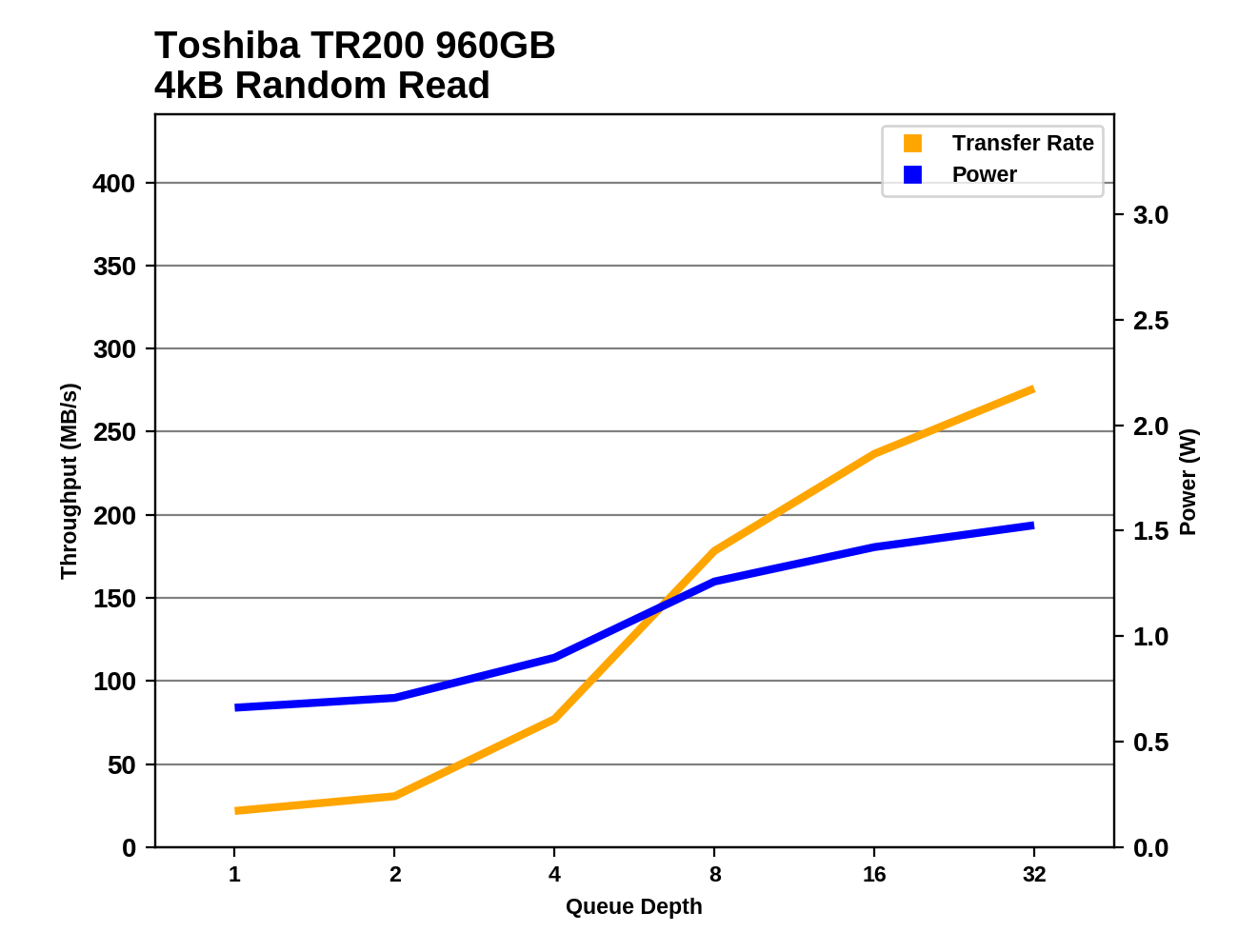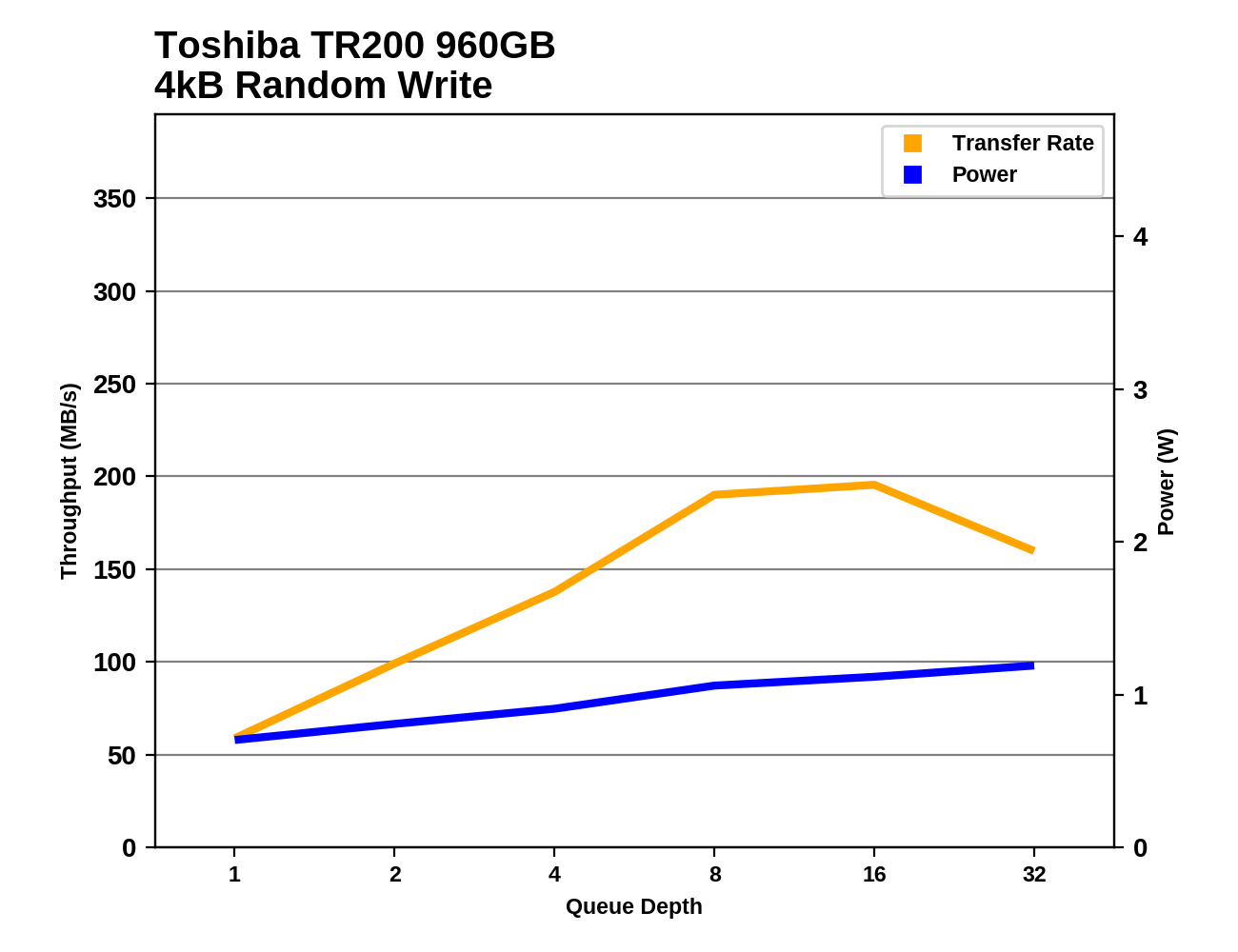The Toshiba TR200 3D NAND SSD Review: One Step Forward, One Step Back
by Billy Tallis on October 11, 2017 7:00 AM ESTRandom Read Performance
Our first test of random read performance uses very short bursts of operations issued one at a time with no queuing. The drives are given enough idle time between bursts to yield an overall duty cycle of 20%, so thermal throttling is impossible. Each burst consists of a total of 32MB of 4kB random reads, from a 16GB span of the disk. The total data read is 1GB.

The QD1 burst random read speeds of the Toshiba TR200 are mostly normal for a budget SSD, though the 960GB model is notably slower than the smaller capacities that are using the 256Gb NAND dies instead of the 512Gb dies.
Our sustained random read performance is similar to the random read test from our 2015 test suite: queue depths from 1 to 32 are tested, and the average performance and power efficiency across QD1, QD2 and QD4 are reported as the primary scores. Each queue depth is tested for one minute or 32GB of data transferred, whichever is shorter. After each queue depth is tested, the drive is given up to one minute to cool off so that the higher queue depths are unlikely to be affected by accumulated heat build-up. The individual read operations are again 4kB, and cover a 64GB span of the drive.

On the longer test that includes higher queue depths, the Toshiba TR200 falls to near the bottom of the chart. The 240GB and 960GB models are substantially slower than anything else we've tested of similar capacity. On the other hand, the 480GB TR200 is tied with the 525GB Crucial MX300, and the trend suggests that the 275GB Crucial MX300 would score a bit worse.

The power efficiency of the Toshiba TR200 during random reads is good, and a clear improvement over the TR150. Notably, the 960GB TR200 scores about the same as the SanDisk Ultra 3D 1TB, showing that the latter's higher performance is in proportion to the power cost of its DRAM.
 |
|||||||||
The TR200s all show very little random read performance increase from QD1 to QD2, and this is most of why their performance scores above are so low. Through the mid range of queue depths, the TR200 shows better scaling than many other budget SSDs, but at the high end the performance increases taper off. The 960GB model never provides substantially higher performance than the 480GB model, as both have the same number of NAND dies.
Random Write Performance
Our test of random write burst performance is structured similarly to the random read burst test, but each burst is only 4MB and the total test length is 128MB. The 4kB random write operations are distributed over a 16GB span of the drive, and the operations are issued one at a time with no queuing.

The Toshiba TR200s are the slowest drives for short bursts of random writes at QD1. The larger drives are slower, a pattern that the TR150 and several other models exhibit.
As with the sustained random read test, our sustained 4kB random write test runs for up to one minute or 32GB per queue depth, covering a 64GB span of the drive and giving the drive up to 1 minute of idle time between queue depths to allow for write caches to be flushed and for the drive to cool down.

On the longer test of random writes involving some higher queue depths, the gap between the TR200 and a typical mainstream SATA SSD widens to a factor of two or more, but the TR200 also ends up ahead of the HP S700 and the original Trion 100.

In spite of the poor sustained random write performance, the Toshiba TR200 shows above average power efficiency. This is a huge change relative to previous Trion/TR series drives, which were the least efficient drives on this test. The HP S700 also showed very poor efficiency during random writes.
 |
|||||||||
The 960GB TR200 shows steady performance scaling as queue depths increase, but by the end of the test its SLC cache has filled up and performance begins to drop. The smaller TR200s also saturate by around QD8 and hold steady at very low performance levels. Power also stays low even at higher QDs, with the 240GB model never exceeding 1W.










50 Comments
View All Comments
lmcd - Thursday, October 12, 2017 - link
Isn't BX300 NVMe? Or is it SATA? 850 Evo might be the best "compatibility" option if the former.mapesdhs - Friday, October 13, 2017 - link
Curiously though, the 850 EVO still has a very good reputation. But for the price, it would be my default recommendation.sonny73n - Saturday, October 14, 2017 - link
All three are SATA3.takeshi7 - Wednesday, October 11, 2017 - link
Anandtech reviewed the Crucial BX300 and it seems very good.Samus - Wednesday, October 11, 2017 - link
BX300 is the only competitive drive at the moment (mostly on price) but older MX200’s can occasionally be found cheap and they have the capacity advantage.sonny73n - Thursday, October 12, 2017 - link
Are you capable of using the search function on AT?Ratman6161 - Thursday, October 12, 2017 - link
Seriously dude, your mom densest want an SSD for Christmas.HollyDOL - Wednesday, October 11, 2017 - link
Hm, with given price the performance is really poor... Unless you absolutely need to cut power requirements down in mW scale for some reason, I can't imagine it being a good choice.Valantar - Wednesday, October 11, 2017 - link
If this does indeed signal the beginning of the end of the NAND shortage, that is more than welcome. If that happens, I also hope we see significant reductions below MSRP for this over time, to the tune of i being noticeably cheaper than DRAM-equipped drives. In the next year, I want cheap 250-500GB SSDs for my XBONE and PS4, and DRAM-less drives should fit that bill nicely (the USB interface will limit them already, so I don't see the value of springing for anything above bargain-basement as long as it significantly outperforms an HDD).nathanddrews - Wednesday, October 11, 2017 - link
With 100GB games already shipping, will 250-500GB cut it anymore?